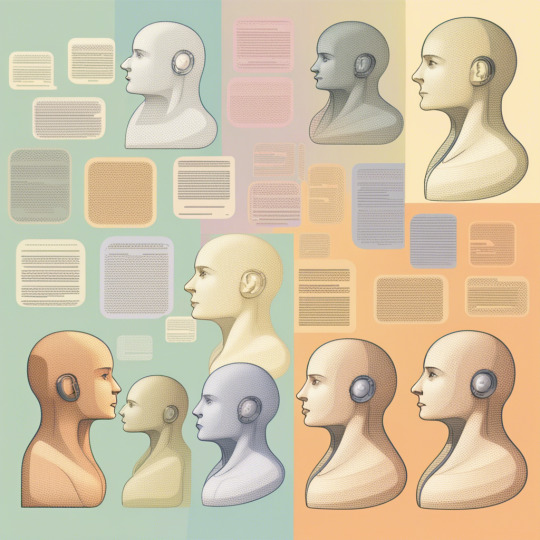#Artificial Neural Networks
Text
The Way the Brain Learns is Different from the Way that Artificial Intelligence Systems Learn - Technology Org
New Post has been published on https://thedigitalinsider.com/the-way-the-brain-learns-is-different-from-the-way-that-artificial-intelligence-systems-learn-technology-org/
The Way the Brain Learns is Different from the Way that Artificial Intelligence Systems Learn - Technology Org
Researchers from the MRC Brain Network Dynamics Unit and Oxford University’s Department of Computer Science have set out a new principle to explain how the brain adjusts connections between neurons during learning.
This new insight may guide further research on learning in brain networks and may inspire faster and more robust learning algorithms in artificial intelligence.
Study shows that the way the brain learns is different from the way that artificial intelligence systems learn. Image credit: Pixabay
The essence of learning is to pinpoint which components in the information-processing pipeline are responsible for an error in output. In artificial intelligence, this is achieved by backpropagation: adjusting a model’s parameters to reduce the error in the output. Many researchers believe that the brain employs a similar learning principle.
However, the biological brain is superior to current machine learning systems. For example, we can learn new information by just seeing it once, while artificial systems need to be trained hundreds of times with the same pieces of information to learn them.
Furthermore, we can learn new information while maintaining the knowledge we already have, while learning new information in artificial neural networks often interferes with existing knowledge and degrades it rapidly.
These observations motivated the researchers to identify the fundamental principle employed by the brain during learning. They looked at some existing sets of mathematical equations describing changes in the behaviour of neurons and in the synaptic connections between them.
They analysed and simulated these information-processing models and found that they employ a fundamentally different learning principle from that used by artificial neural networks.
In artificial neural networks, an external algorithm tries to modify synaptic connections in order to reduce error, whereas the researchers propose that the human brain first settles the activity of neurons into an optimal balanced configuration before adjusting synaptic connections.
The researchers posit that this is in fact an efficient feature of the way that human brains learn. This is because it reduces interference by preserving existing knowledge, which in turn speeds up learning.
Writing in Nature Neuroscience, the researchers describe this new learning principle, which they have termed ‘prospective configuration’. They demonstrated in computer simulations that models employing this prospective configuration can learn faster and more effectively than artificial neural networks in tasks that are typically faced by animals and humans in nature.
The authors use the real-life example of a bear fishing for salmon. The bear can see the river and it has learnt that if it can also hear the river and smell the salmon it is likely to catch one. But one day, the bear arrives at the river with a damaged ear, so it can’t hear it.
In an artificial neural network information processing model, this lack of hearing would also result in a lack of smell (because while learning there is no sound, backpropagation would change multiple connections including those between neurons encoding the river and the salmon) and the bear would conclude that there is no salmon, and go hungry.
But in the animal brain, the lack of sound does not interfere with the knowledge that there is still the smell of the salmon, therefore the salmon is still likely to be there for catching.
The researchers developed a mathematical theory showing that letting neurons settle into a prospective configuration reduces interference between information during learning. They demonstrated that prospective configuration explains neural activity and behaviour in multiple learning experiments better than artificial neural networks.
Lead researcher Professor Rafal Bogacz of MRC Brain Network Dynamics Unit and Oxford’s Nuffield Department of Clinical Neurosciences says: ‘There is currently a big gap between abstract models performing prospective configuration, and our detailed knowledge of anatomy of brain networks. Future research by our group aims to bridge the gap between abstract models and real brains, and understand how the algorithm of prospective configuration is implemented in anatomically identified cortical networks.’
The first author of the study Dr Yuhang Song adds: ‘In the case of machine learning, the simulation of prospective configuration on existing computers is slow, because they operate in fundamentally different ways from the biological brain. A new type of computer or dedicated brain-inspired hardware needs to be developed, that will be able to implement prospective configuration rapidly and with little energy use.’
Source: University of Oxford
You can offer your link to a page which is relevant to the topic of this post.
#A.I. & Neural Networks news#algorithm#Algorithms#Anatomy#Animals#artificial#Artificial Intelligence#artificial intelligence (AI)#artificial neural networks#Brain#Brain Connectivity#brain networks#Brain-computer interfaces#brains#bridge#change#computer#Computer Science#computers#dynamics#ear#employed#energy#fishing#Fundamental#Future#gap#Hardware#hearing#how
2 notes
·
View notes
Text
The Evolution of ERP from Servitude to Liberation via AI and the No-Code Revolution | USAII®
Embrace the No-code revolution with finesse and give way to staggering emerging technologies in business. Evolve with the dynamic diaspora of ERP evolution with nuanced expertise.
Read more: https://shorturl.at/ekwP2
Artificial Neural Networks, Convolutional Neural Networks, Large Language Models (LLMs), digital transformation, AI/ML models, chatbots, AI Libraries
0 notes
Text
0 notes
Text
1 note
·
View note
Text
I think it's interesting how there's this whole "ai is not a fad, it's the new technical revolution" but image generation has already shifted from an innovation to a polution of where art should be and text generation from a useful tool for figuring things out to a source of accidental misinformation. like i don't know if its the association with bad actors or if i have grown less easily impressed but generative neural networks just don't feel that important anymore
#artificial intelligence#artificial neural networks#thoughts#may also just be a cultural climate that is being climated at me by tumblr
0 notes
Text
Here Are the Top AI Stories You Missed This Week
Photo: Aaron Jackson (AP)
The news industry has been trying to figure out how to deal with the potentially disruptive impact of generative AI. This week, the Associated Press rolled out new guidelines for how artificial intelligence should be used in its newsrooms and AI vendors are probably not too pleased. Among other new rules, the AP has effectively banned the use of ChatGPT and other AI in…

View On WordPress
#artificial intelligence#Artificial neural networks#chatgpt#Emerging technologies#Generative artificial intelligence#Generative pre-trained transformer#Gizmodo#Google#Hallucination#Large language models#Lula#OPENAI#Werner Herzog
0 notes
Text
The Evolution of Generative AI Platforms: How Large Language Models will Disrupt Business and Society
Large language models (LLMs) like ChatGPT and Google Bard have captured the public’s imagination recently with their ability to generate remarkably human-like text. However, this is just the beginning. As LLMs become more powerful, integrating them with other systems will evolve them into full-fledged platforms and unlock their capabilities even further. These LLM platforms have the potential to…

View On WordPress
#AI#artificial intelligence#artificial neural networks#business#ChatGPT#GenAI#generative AI#leadership#Leadership and Management#management#Natural Language Generation#Natural Language Processing#OpenAI#society
0 notes
Text
Unleashing the Power of Artificial Neural Networks: Revolutionizing the Future of Technology
0 notes
Text
AI’s Inner Dialogue: How Self-Reflection Enhances Chatbots and Virtual Assistants
New Post has been published on https://thedigitalinsider.com/ais-inner-dialogue-how-self-reflection-enhances-chatbots-and-virtual-assistants/
AI’s Inner Dialogue: How Self-Reflection Enhances Chatbots and Virtual Assistants
Recently, Artificial Intelligence (AI) chatbots and virtual assistants have become indispensable, transforming our interactions with digital platforms and services. These intelligent systems can understand natural language and adapt to context. They are ubiquitous in our daily lives, whether as customer service bots on websites or voice-activated assistants on our smartphones. However, an often-overlooked aspect called self-reflection is behind their extraordinary abilities. Like humans, these digital companions can benefit significantly from introspection, analyzing their processes, biases, and decision-making.
This self-awareness is not merely a theoretical concept but a practical necessity for AI to progress into more effective and ethical tools. Recognizing the importance of self-reflection in AI can lead to powerful technological advancements that are also responsible and empathetic to human needs and values. This empowerment of AI systems through self-reflection leads to a future where AI is not just a tool, but a partner in our digital interactions.
Understanding Self-Reflection in AI Systems
Self-reflection in AI is the capability of AI systems to introspect and analyze their own processes, decisions, and underlying mechanisms. This involves evaluating internal processes, biases, assumptions, and performance metrics to understand how specific outputs are derived from input data. It includes deciphering neural network layers, feature extraction methods, and decision-making pathways.
Self-reflection is particularly vital for chatbots and virtual assistants. These AI systems directly engage with users, making it essential for them to adapt and improve based on user interactions. Self-reflective chatbots can adapt to user preferences, context, and conversational nuances, learning from past interactions to offer more personalized and relevant responses. They can also recognize and address biases inherent in their training data or assumptions made during inference, actively working towards fairness and reducing unintended discrimination.
Incorporating self-reflection into chatbots and virtual assistants yields several benefits. First, it enhances their understanding of language, context, and user intent, increasing response accuracy. Secondly, chatbots can make adequate decisions and avoid potentially harmful outcomes by analyzing and addressing biases. Lastly, self-reflection enables chatbots to accumulate knowledge over time, augmenting their capabilities beyond their initial training, thus enabling long-term learning and improvement. This continuous self-improvement is vital for resilience in novel situations and maintaining relevance in a rapidly evolving technological world.
The Inner Dialogue: How AI Systems Think
AI systems, such as chatbots and virtual assistants, simulate a thought process that involves complex modeling and learning mechanisms. These systems rely heavily on neural networks to process vast amounts of information. During training, neural networks learn patterns from extensive datasets. These networks propagate forward when encountering new input data, such as a user query. This process computes an output, and if the result is incorrect, backward propagation adjusts the network’s weights to minimize errors. Neurons within these networks apply activation functions to their inputs, introducing non-linearity that enables the system to capture complex relationships.
AI models, particularly chatbots, learn from interactions through various learning paradigms, for example:
In supervised learning, chatbots learn from labeled examples, such as historical conversations, to map inputs to outputs.
Reinforcement learning involves chatbots receiving rewards (positive or negative) based on their responses, allowing them to adjust their behavior to maximize rewards over time.
Transfer learning utilizes pre-trained models like GPT that have learned general language understanding. Fine-tuning these models adapts them to tasks such as generating chatbot responses.
It is essential to balance adaptability and consistency for chatbots. They must adapt to diverse user queries, contexts, and tones, continually learning from each interaction to improve future responses. However, maintaining consistency in behavior and personality is equally important. In other words, chatbots should avoid drastic changes in personality and refrain from contradicting themselves to ensure a coherent and reliable user experience.
Enhancing User Experience Through Self-Reflection
Enhancing the user experience through self-reflection involves several vital aspects contributing to chatbots and virtual assistants’ effectiveness and ethical behavior. Firstly, self-reflective chatbots excel in personalization and context awareness by maintaining user profiles and remembering preferences and past interactions. This personalized approach enhances user satisfaction, making them feel valued and understood. By analyzing contextual cues such as previous messages and user intent, self-reflective chatbots deliver more relevant and meaningful answers, enhancing the overall user experience.
Another vital aspect of self-reflection in chatbots is reducing bias and improving fairness. Self-reflective chatbots actively detect biased responses related to gender, race, or other sensitive attributes and adjust their behavior accordingly to avoid perpetuating harmful stereotypes. This emphasis on reducing bias through self-reflection reassures the audience about the ethical implications of AI, making them feel more confident in its use.
Furthermore, self-reflection empowers chatbots to handle ambiguity and uncertainty in user queries effectively. Ambiguity is a common challenge chatbots face, but self-reflection enables them to seek clarifications or provide context-aware responses that enhance understanding.
Case Studies: Successful Implementations of Self-Reflective AI Systems
Google’s BERT and Transformer models have significantly improved natural language understanding by employing self-reflective pre-training on extensive text data. This allows them to understand context in both directions, enhancing language processing capabilities.
Similarly, OpenAI’s GPT series demonstrates the effectiveness of self-reflection in AI. These models learn from various Internet texts during pre-training and can adapt to multiple tasks through fine-tuning. Their introspective ability to train data and use context is key to their adaptability and high performance across different applications.
Likewise, Microsoft’s ChatGPT and Copilot utilize self-reflection to enhance user interactions and task performance. ChatGPT generates conversational responses by adapting to user input and context, reflecting on its training data and interactions. Similarly, Copilot assists developers with code suggestions and explanations, improving their suggestions through self-reflection based on user feedback and interactions.
Other notable examples include Amazon’s Alexa, which uses self-reflection to personalize user experiences, and IBM’s Watson, which leverages self-reflection to enhance its diagnostic capabilities in healthcare.
These case studies exemplify the transformative impact of self-reflective AI, enhancing capabilities and fostering continuous improvement.
Ethical Considerations and Challenges
Ethical considerations and challenges are significant in the development of self-reflective AI systems. Transparency and accountability are at the forefront, necessitating explainable systems that can justify their decisions. This transparency is essential for users to comprehend the rationale behind a chatbot’s responses, while auditability ensures traceability and accountability for those decisions.
Equally important is the establishment of guardrails for self-reflection. These boundaries are essential to prevent chatbots from straying too far from their designed behavior, ensuring consistency and reliability in their interactions.
Human oversight is another aspect, with human reviewers playing a pivotal role in identifying and correcting harmful patterns in chatbot behavior, such as bias or offensive language. This emphasis on human oversight in self-reflective AI systems provides the audience with a sense of security, knowing that humans are still in control.
Lastly, it is critical to avoid harmful feedback loops. Self-reflective AI must proactively address bias amplification, particularly if learning from biased data.
The Bottom Line
In conclusion, self-reflection plays a pivotal role in enhancing AI systems’ capabilities and ethical behavior, particularly chatbots and virtual assistants. By introspecting and analyzing their processes, biases, and decision-making, these systems can improve response accuracy, reduce bias, and foster inclusivity.
Successful implementations of self-reflective AI, such as Google’s BERT and OpenAI’s GPT series, demonstrate this approach’s transformative impact. However, ethical considerations and challenges, including transparency, accountability, and guardrails, demand following responsible AI development and deployment practices.
#ai#AI models#AI systems#alexa#Amazon#applications#approach#artificial#Artificial Intelligence#artificial neural networks#awareness#Behavior#BERT#Bias#bots#Capture#challenge#chatbot#chatbots#chatGPT#code#code suggestions#continuous#customer service#data#datasets#deployment#developers#development#emphasis
1 note
·
View note
Text
Artificial Neural Networks (ANN) with Keras in Python and R
Artificial Neural Networks (ANN) with Keras in Python and R
Understand Deep Learning and build Neural Networks using TensorFlow 2.0 and Keras in Python and R
What you’ll learn
Get a solid understanding of Artificial Neural Networks (ANN) and Deep LearningLearn usage of Keras and Tensorflow librariesUnderstand the business scenarios where Artificial Neural Networks (ANN) is applicableBuilding a Artificial Neural Networks (ANN) in Python and RUse…
View On WordPress
0 notes
Text
Detecting AI-generated research papers through "tortured phrases"
So, a recent paper found and discusses a new way to figure out if a "research paper" is, in fact, phony AI-generated nonsense. How, you may ask? The same way teachers and professors detect if you just copied your paper from online and threw a thesaurus at it!
It looks for “tortured phrases”; that is, phrases which resemble standard field-specific jargon, but seemingly mangled by a thesaurus. Here's some examples (transcript below the cut):

profound neural organization - deep neural network
(fake | counterfeit) neural organization - artificial neural network
versatile organization - mobile network
organization (ambush | assault) - network attack
organization association - network connection
(enormous | huge | immense | colossal) information - big data
information (stockroom | distribution center) - data warehouse
(counterfeit | human-made) consciousness - artificial intelligence (AI)
elite figuring - high performance computing
haze figuring - fog/mist/cloud computing
designs preparing unit - graphics processing unit (GPU)
focal preparing unit - central processing unit (CPU)
work process motor - workflow engine
facial acknowledgement - face recognition
discourse acknowledgement - voice recognition
mean square (mistake | blunder) - mean square error
mean (outright | supreme) (mistake | blunder) - mean absolute error
(motion | flag | indicator | sign | signal) to (clamor | commotion | noise) - signal to noise
worldwide parameters - global parameters
(arbitrary | irregular) get right of passage to - random access
(arbitrary | irregular) (backwoods | timberland | lush territory) - random forest
(arbitrary | irregular) esteem - random value
subterranean insect (state | province | area | region | settlement) - ant colony
underground creepy crawly (state | province | area | region | settlement) - ant colony
leftover vitality - remaining energy
territorial normal vitality - local average energy
motor vitality - kinetic energy
(credulous | innocent | gullible) Bayes - naïve Bayes
individual computerized collaborator - personal digital assistant (PDA)
87 notes
·
View notes
Text
Thought: we shouldn't be calling all these "AI" things Artificial Intelligence.
Instead, I propose we use the term "Algorithmic Generators", or "AG" for short, for these types of things.
Because that better explains what they actually are, and also doesn't incorrectly peg them as "intelligent" or cause confusion about what AI actually mean anymore.
106 notes
·
View notes
Link
One of the biggest challenges in the machine learning space today is the problem of credit assignment: the identification of the components within the information processing pipeline and pinpointing which are responsible for any errors that crop up in the output generated by the algorithm. The common assumption is that the problem is best resolved through the use of a process known as backpropagation, but this presents significant issues. A new mechanism has now been proposed by researchers from the MRC Brain Network Dynamics Unit and Oxford University’s Department of Computer Science that has the potential to bridge these gaps and is capable of reproducing observed neural activity patterns in humans.
The problem of credit assignment is one that is fundamental to machine learning. One proposed theory, backpropagation, has been remarkably successful and has resulted in the advancement of artificial intelligence as well as neural mechanisms. Due to the success of backpropagation, there has been significant interest in the study of backpropagation as it applies to biological learning mechanisms. Though these models may not implement it directly, backpropagation is used as the standard against which they are approximated. However, in recent years, it has become increasingly obvious that the remarkable capacity of the biological neural system far surpasses that of backpropagation; it requires significantly fewer exposures to stimuli in order to learn a response, and information storage is far more efficient and resilient.
Instead, it is proposed that credit assignment within the brain follows an entirely different principle called “prospective configuration.” Under this, the conventional order followed by backpropagation is reversed; instead of initial synaptic weight modification succeeded by changes in neural activity, which is changed across the neural network such that the neurons can better predict target outputs, after which the synaptic weights are modified as necessary.
Continue Reading
50 notes
·
View notes
Text
Meta's Set to Drop a Code-Generating AI Bot
Meta’s language-centric LlaMA AI will soon find itself in the company of a nerdier, coding wiz brother. The company’s next AI release will reportedly be a big coding machine meant to compete against the proprietary software from the likes of OpenAI and Google. The model could see a release as soon as next week.
Why is Everyone Suing AI Companies? | Future Tech
According to The Information who…

View On WordPress
#AI boom#artificial intelligence#Artificial neural networks#chatgpt#Deep learning#facebook#Generative pre-trained transformer#GitHub#Gizmodo#Google#Internet#Large language models#LLaMA#Mark Zuckerberg#META#Meta AI#Meta Platforms#Microsoft#OPENAI#Sarah Silverman#Technology
0 notes
Text
Reinventing How We Will Consume Information: LLM-Powered Agents as Superhuman Guides with Immense Knowledge and Teachers with Infinite Patience
I write this blog post to explore an emerging frontier in the way we consume information – one that will have profound implications for the way we read, learn, and interact with complex content. This new frontier is heralded by the advent of large language models (LLMs), powerful generative AI that can understand and generate text, answer questions, and translate languages.
On June 10, 2023, I…

View On WordPress
#artificial intelligence#artificial neural networks#CTO#LanguageModels#Large Language Models#LLM#OpenAI#technology
0 notes